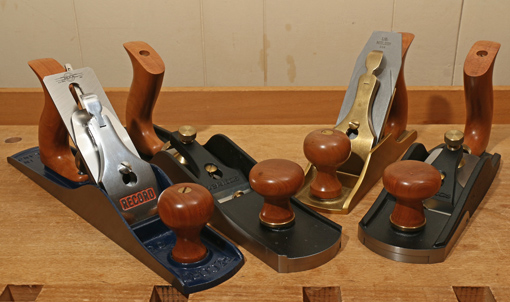
With their new line of customizable hand planes, Lee Valley/Veritas continues their impressive record of innovation in woodworking tools. Within each plane size, you can choose the blade steel, the handles (thankfully), and the frog.
The most compelling option, in my view, is the choice of frogs, and particularly in a smoothing plane. This gives us yet another way to vary the attack angle. This is simply how high is the angle (from horizontal) of the top surface of the blade at its very edge. In other words, it is the angle at which the blade meets the wood. This is one of several factors, a critical one, in reducing the dreaded tearout of hand planing.
Let’s look at the mainstream options for attack angle that we’ve had so far
In bevel-up bench planes, the blade is usually bedded at 12°, though I continue to assert that 20° – 22° would be better. The attack angle is determined by the bed angle plus the sharpening angle of the most distal bevel, usually a secondary or micro bevel. For example, a blade with a 38° secondary bevel sitting on a 12° frog, gives a 50° attack angle.
By maintaining multiple blades or re-honing a single blade, you have your choice of attack angles. By the way, because the wear occurs more on the bottom surface of the blade, the Charlesworth “ruler trick” is especially helpful when sharpening bevel-up blades.
In bevel-down planes, most are made with 45° frogs but Lie-Nielsen offers a choice of 45°, 50°, and 55° frogs for most of their great bench planes. I like the 50° frog in my L-N #4 smoother. The attack angle in a bevel-down plane is usually determined simply by the bed angle. The nifty exception is the back bevel, which is a tiny bevel on the (otherwise) flat side of the blade. For example, in addition to conventionally sharpened blades for my #4, I keep one prepared with a 10° back bevel to produce, with the 50° frog, an attack angle of 60°.
What’s new
Now Veritas, with their awesome manufacturing capabilities, offers a full range of bevel-down planes with your choice of frog angle from 40° to 65° in 0.5° increments. Furthermore, extra frogs can be ordered that can be easily swapped into your plane. So, you could outfit your #4 smoother with a 45° frog and an O-1 blade for a project in pine, then swap over to a 57.5° frog and a PM V-11 blade for a project in figured maple. The caveat is, of course, that I haven’t used these new planes so I cannot judge if their innovative design actually performs well at the bench.
All of this means we have more choices and a greater, though happier, burden of choosing. Obviously, each of us does not need or want every tool and option available, so it is more important than ever to make intelligent choices in tools.


And helping us to make intelligent choices in tools is the purview of the Heartwood blog. I foresee some incremental frog angles making their way into your tool cabinet.
Thanks, Tico. Haha, it may be a good thing that I’m running out of room in my tool cabinet.